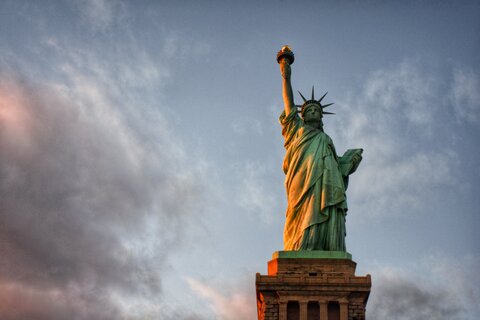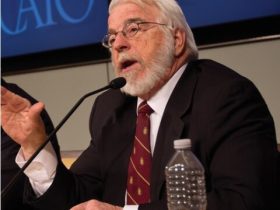Colin Grabow
My family spent Thanksgiving in New York City, where we did many of the usual tourist things such as a picture with Wall Street’s Charging Bull sculpture, ice skating in Central Park, and a (mercifully short) visit to Times Square. The first item on our sightseeing agenda, however, was the Statue of Liberty. Looking at the ferry that would transport us, I was struck by an underappreciated paradox. Visitors to the world’s most famous monument to liberty are transported by vessels rooted in coercion.
Despite the US’s free market reputation, the country is home to some of the world’s most restrictive maritime cabotage laws, including the Jones Act and (most relevant for ferries) the Passenger Vessel Services Act. Among their requirements is that vessels transporting goods or people within the United States — including the transfer of visitors to Liberty Island — be constructed in US shipyards.
In the land of the free, foreign-built ferries (and other vessels) are strictly off-limits.
After boarding our ferry, I quickly located its certificate of inspection. It showed that the vessel, the Statue of Liberty V, was quickly approaching its 48th birthday having been delivered on January 1, 1977.
The ferry’s advanced age wasn’t much of a surprise. Thanks to the high cost of new construction in US shipyards — which almost entirely subsist on sales to the protected domestic market — vessels ranging from tugboats to containerships to fishing vessels tend to be significantly older than those used in other countries.
Indeed, only minutes after our departure I spotted another aging vessel, the tugboat Lucy Reinauer. Built in 1973 (compared to an average build year of 2001 for foreign seagoing tugs), the tugboat was paired with the barge RTC 60 to form an articulated tug barge (ATB). Developed as a response to the high cost of building and crewing vessels within the protected US market, ATBs are relatively little used outside the United States. That countries without restrictions on where vessels can be purchased — i.e. the rest of the world — largely avoid ATBs suggests their employment is less than optimal.
Theoretically, prohibiting foreign-built vessels assures the United States of a robust shipbuilding sector. In reality, the restriction has produced a fleet that is significantly older than its international peers while failing to generate much in the way of new vessel construction. Last year, the US commercial shipbuilding industry accounted for 0.1 percent of global output, placing it roughly on par with Iran.
The shipyards that built the Statue of Liberty V and the Lucy Reinauer closed decades ago.
But back to the ferry. After a short time, we arrived at Liberty Island and climbed the 215 steps (useful for working off Thanksgiving gluttony) of the Statue of Liberty’s pedestal for some excellent views of New Jersey and Manhattan.
Later, we boarded another ferry on the wrong side of 40, the 1981-built Hornblower Freedom, for a quick stop at Ellis Island and then a return to Lower Manhattan. Along the way, I spotted the Staten Island Ferry, which appeared to be one of three Molinari class vessels delivered between 2003–2004. Purchased for $140 million, the Molinari class ferries drew attention in 2014 for their frequent mechanical problems.
More recently, three more similar-sized Staten Island ferries were purchased from a Florida shipyard for $314 million. Although it’s unclear what they would have cost if built abroad, the fact the shipyard that built the ferries has never constructed one for the competitive international market suggests an inflated price tag.
Arriving back at Battery Park, I couldn’t help thinking about the benefits that could be realized if Americans had access to vessels from world-class international shipyards. Imagine the cost savings. Imagine the efficiency gains from fleets of new, modern vessels zipping around New York Harbor and other US waters. Imagine if we had that kind of liberty.








